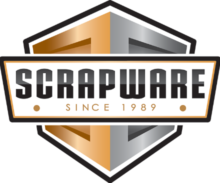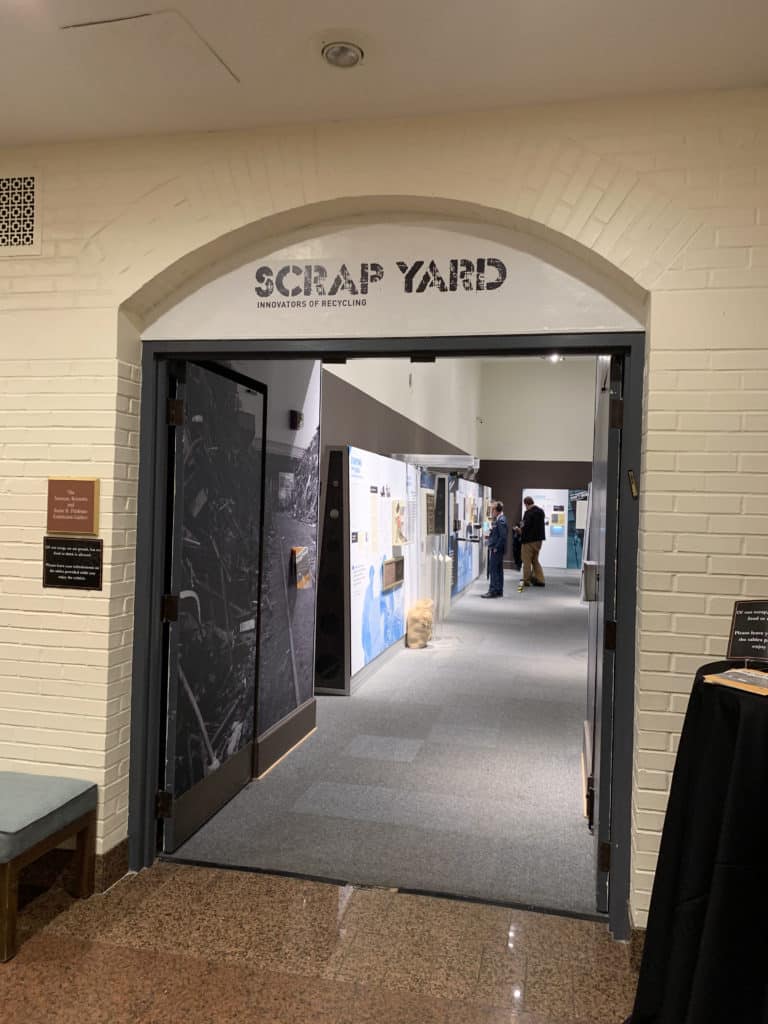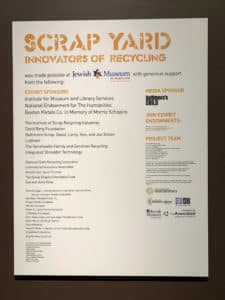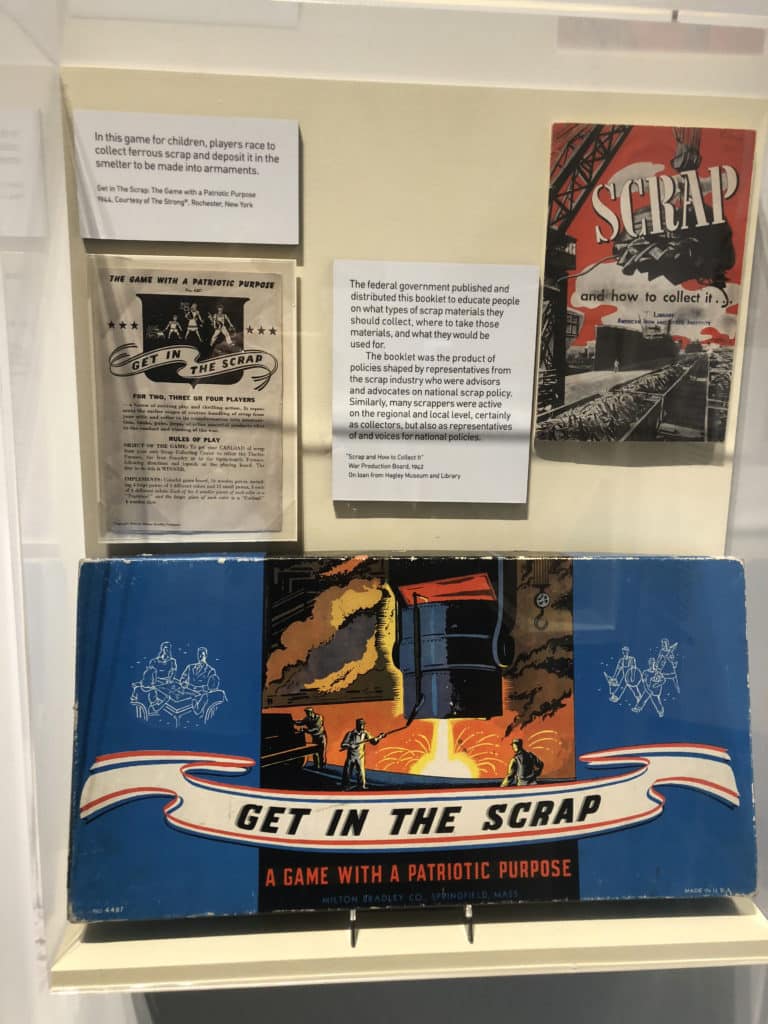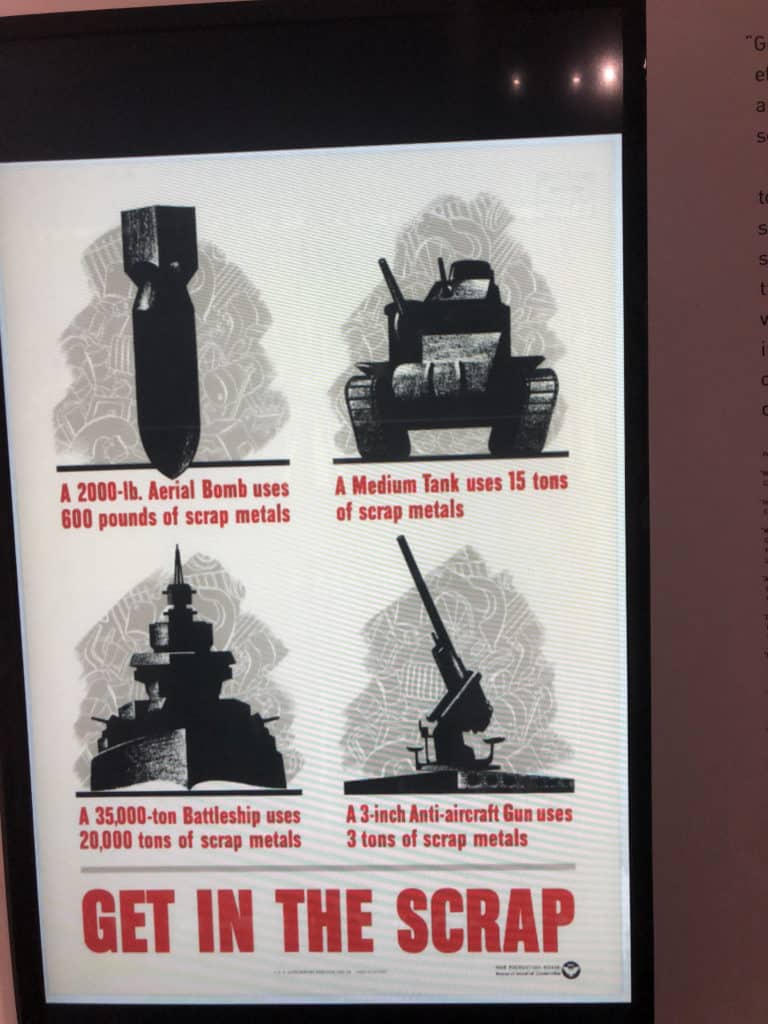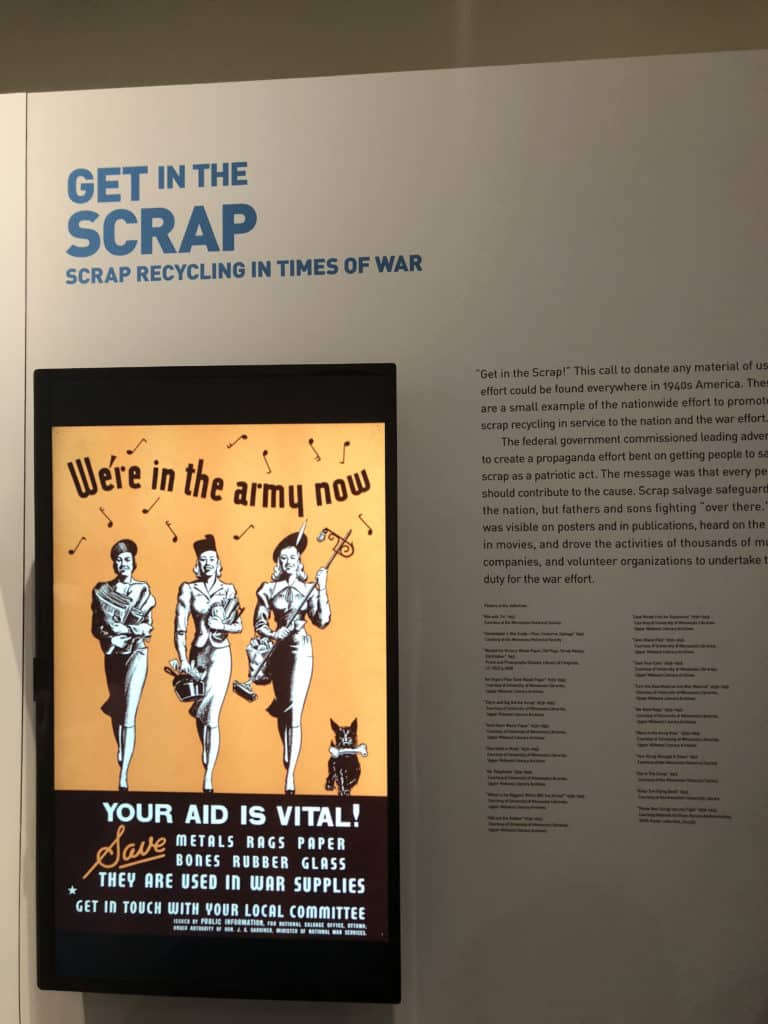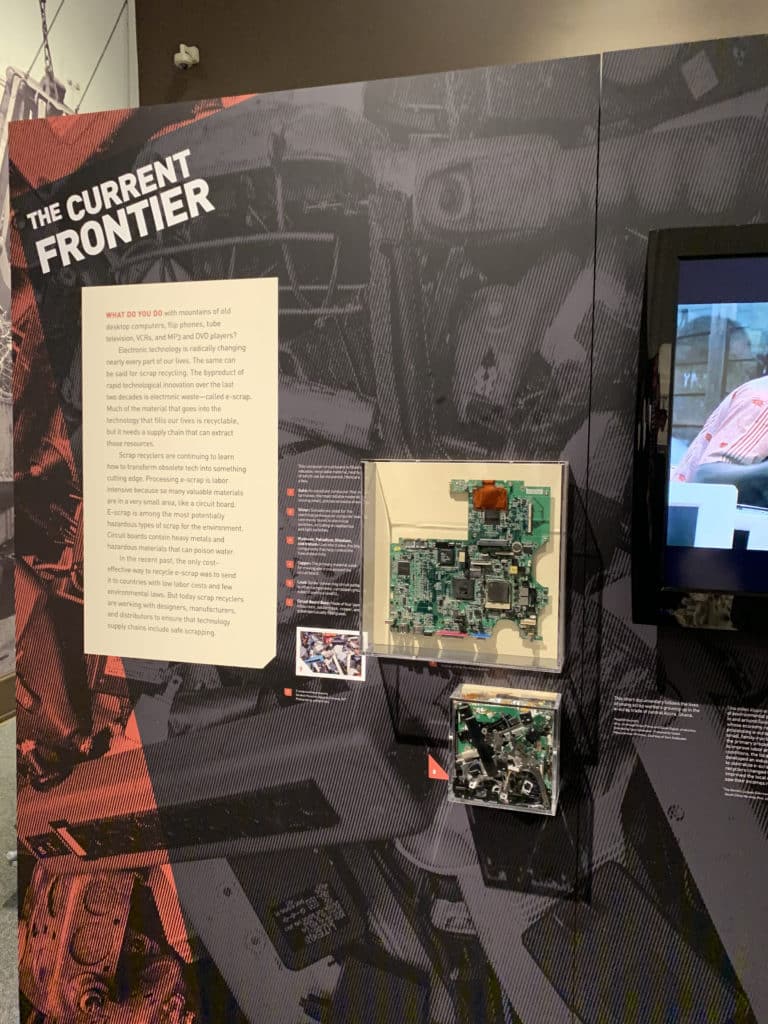The Riches of Rag and Bone. Scrap in Popular Culture. Scrap Recycling in Times of War.
What do these topics have in common? These topics, and more, are explored in a new exhibit at the Jewish Museum of Maryland, “Scrap Yard: Innovators of Recycling.” The exhibition, which opened at the Baltimore museum last October, traces the history of scrap yards in the United States and the prominent role of the Jewish community in the success of the scrap metal recycling industry.
ScrapWare Corporation is proud to be one of the “Scrap Yard” exhibit sponsors.
The exhibit program introduces this timely topic, making the following reflection on scrapping history:
“For over 200 years, discarded ‘junk’—metals, rags, paper, glass, and more, have provided economic opportunities for immigrants and native-born Americans who collected, transformed, and sold it—scrappers: peddlers, collectors, dealers, scrapyard workers, and brokers.
The work was grueling, the job was not always respected, and the industry was often criticized as a source of social and environmental problems. But generations of Americans new and old found themselves making a life’s work in the yard—including may Jewish scrappers, who at one time represented up to ninety percent of the industry.”
These scrap peddlers were the originators of what we now call the recycling industry today. The interactive exhibit has various sections examining the history of scrap yard processes and tools and the generations of people who built up the industry, including during times of war, how this was reflected in popular culture, and where the industry is headed today. Below are a few highlights from some of the exhibition sections on display at the museum.
“Starting from Scrap”
In the late 1800s, about 1880, a massive influx of European immigrants were coming to the United States. Many were looking for a way to make a living that required little English and little capital. These immigrants, mainly from Eastern and Southern Europe, started to gather and resell scrap metals and other scrap materials, often with just a pushcart or a sack. The exhibit section “Starting from Scrap” talks about these peddlers, many of them Jewish, and their scrap families.
“They could be heard bellowing for rags and metal in city streets and seen buying materials on farms and homesteads. They founded businesses in small towns, ports, and transportation hubs, as well as in rural settlements.”
As the industrial revolution fueled the growth of these enterprises, their work included:
- Collecting scrap– Women and children would join in this work, gathering small, light amounts of scrap by salvaging in their communities.
- Peddling scrap– This involved buying and selling small amounts of scrap from their carts, sacks, or wagons.
- Dealing scrap– As their business grew, dealers would purchase large amounts of post-consumer and industrial scrap, including military surplus. This type of operation would have to be from a shop or a yard.
- Processing scrap– This required sorting and breaking down collected objects into smaller raw materials that could be resold using simple tools.
As their enterprises expanded, to stay profitable, peddlers had to find ways to process more materials in a shorter period. Sacks, wagons, and carts could no longer carry all their inventory. This challenge eventually required the use of trucks. Hand tools finally gave way to machines to break apart and process items. The exhibit states that by the end of the 1920s, there were about 150,000 scrap businesses in the United States. In the scrap metal recycling industry, recyclable materials include both ferrous and non-ferrous metals–everything from steel, iron, stainless steel, wrought iron, copper, and brass.
Automation Advances, Employment Opportunities Arise
As these scrap businesses grew, so did their needs. It was no longer possible to convert all their collected objects with simple tools and a few people. Growing recycling businesses needed automation and skilled labor to use it. Large operations required industrial-sized scales, and eventually shears, shredders, magnates, cranes, and furnaces. These labor and technology developments propelled recyclers toward the industrialized businesses that they are today. Until the end of the 20th century, about 70 to 90 percent of scrap companies remained Jewish owned, according to the exhibit. However, jobs within the scrap metal recycling industry attract many immigrants and minorities today.
Scrap in Popular Culture
Scrapping history eventually wove its way into our art and entertainment. The exhibit section “Scrap in Popular Culture” uses interactive displays to illustrate how pop culture depicted the “scrap man.” By tapping an exhibit touch screen, museum visitors can hear the 1941 song “Get Some Cash for Your Trash,” by Fats Waller; “Charlie and Fred,” by the Hollies; and the 2007 song “Rag and Bone,” by the White Stripe. Visitors can also watch a short clip of the beloved old sitcom, “Sanford and Son.” This popular comedy from the 1970s was about a family in the scrap business and their weekly adventures. In early depictions, scrappers were characterized as dirty and unkempt. As times changed, however, they became to be depicted as industrious entrepreneurs, contributing to the environment and the economy.
World War II and Recycling Scrap
“Turn this Raw Material into War Material,” calls out a wartime poster in this exhibit section on the scrap industry and WW II.
No exhibit on metals industry history would be complete without an examination of the need for scrap metal in wartime. The war had a significant impact on the growth and development of scrap metal recycling. As the war effort required a great deal of recycled material, recycling scrap metal became a patriotic duty in American homes. “Get in the Scrap,” became the government slogan encouraging Americans to donate material for use in the weapons and vehicles needed to win the war. This section of the exhibit has an impressive display of posters, booklets, and even a board game developed to promote the cause and encourage more Americans to recycle.
As the need for recycled material increased, recyclers had to come up with better ways to process more material in a faster, more efficient manner. This inspired innovation fueled industry growth and improved the reputation of the scrap metal recycling industry. After the war, this growth did not slow down, as there was a new demand to take old wartime scrap and recycle it into new consumer products like components for homes and automobiles.
“The Current Frontier” – Processing e-scrap
One of the exhibit’s final sections explores the recycling industry’s new challenge of learning to recycle discarded technology efficiently. Many of us have drawers of old devices; we are unsure about how to dispose of old iPods, phones, obsolete tablets, and other items. Add to this the piles of larger items, like old computer monitors, televisions, VCR and DVD players. This electronic waste is called e-scrap in the industry. It is different than traditional scrap recycling because the valuable reusable materials are in tiny areas and small quantities, making the process very labor-intensive. Although not initially very profitable, it is nonetheless crucial: e-scrap can be very harmful to the environment because of the hazardous materials in the circuit boards.
In this exhibit section, an old computer circuit board is mounted to the wall. Alongside it is a listing of all the valuable recyclable material contained in it, nearly all of which can be recovered. The circuit board includes, among other things: gold, as an excellent conductor; sliver, used for electrical pathways; platinum, palladium, rhodium, and iridium to coat electrodes; copper, the primary material used for moving electrons; lead used to solder connecting circuit paths.
Because of the valuable materials included in e-Scrap and the cost of recovering them, today scrap recyclers are working with designers and manufacturers to help develop safe scrapping practices for electronic devices.
The Importance of “Scrap Yard”
For environmental and economic reasons, scrap metal recycling remains a vital industry today. To help foster industry recognition and growth, an understanding of its role in our nation’s history is essential. The Jewish Museum of Maryland was awarded grants from both The Institute for Museum and Library Services and The National Endowment for the Humanities to make this exhibit possible. Many other contributors include companies and individuals in the scrap metal recycling industry, many from Maryland. Scrapware Corporation is proud to contribute to this educational effort. Our software plays an essential role in helping scrap metal recycling companies improve efficiency and profitability. This exhibit should help us all remember–the next time we drop something in a recycling bin, thank the original recycling innovators–the immigrant peddlers with a pushcart—for founding the industry to help us preserve our natural resources.
“Scrap Yard” will remain on display in Baltimore until April 26 of this year. “Scrap Yard” hopes to then go on the road, visiting other museums across the country, to tell the story about the evolution of this industry so crucial to the environment and our future. As the museum program concludes: “The horse and buggy days of scrap are long gone. Scrap recycling has grown, and the scrap yard has become larger and more complex. Still, small scale collectors remain important to the industry. Look around, and you’ll see scrap yard bound pickup trucks full of old appliances, furniture, and bicycles or people salvaging aluminum cans to sell for scrap.”
To read more about the exhibit, visit its website: ScrapYardExhibit.org.
About ScrapWare Corporation: Since 1989, Rockville, Maryland-based ScrapWare Corporation has been the software of choice for the recycling industry. Its ease of installation and simplicity saves users time and money, while helping them achieve compliance and maintain accurate business insights. With state-of-the-art functionality that‘s tailored to each organization’s unique requirements, ScrapWare is an advanced dynamic software solution that alleviates the most pressing recycling industry worries. For more information, please call (301) 517-8500 or visit https://www.scrapware.com/.
